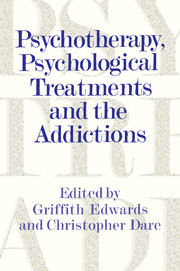Book contents
- Frontmatter
- Contents
- List of contributors
- Psychotherapy and psychological treatments of substance problems: generalism, specialism and the building of bridges
- Acknowledgements
- Part one Backgrounds to therapeutic understanding
- Part two Treatments
- 5 Psychotherapy: why do some need more and some need less?
- 6 Addictive behaviour: the next clinic appointment
- 7 Advances in families and couples therapy
- 8 Solution focused brief therapy: a co-operative approach to work with clients
- 9 Recent developments in cognitive and behavioural therapies
- 10 Cognitive and behavioural treatments for substance misuse
- 11 Motivational issues in the treatment of addictive behaviour
- 12 Can ‘stages of change’ provide guidance in the treatment of addictions? A critical examination of Prochaska and DiClemente's model
- 13 Group therapy and the addictions
- 14 Alcoholics Anonymous as mirror held up to nature
- 15 How therapeutic communities work
- Part three Postscript
- Index
8 - Solution focused brief therapy: a co-operative approach to work with clients
from Part two - Treatments
Published online by Cambridge University Press: 05 August 2016
- Frontmatter
- Contents
- List of contributors
- Psychotherapy and psychological treatments of substance problems: generalism, specialism and the building of bridges
- Acknowledgements
- Part one Backgrounds to therapeutic understanding
- Part two Treatments
- 5 Psychotherapy: why do some need more and some need less?
- 6 Addictive behaviour: the next clinic appointment
- 7 Advances in families and couples therapy
- 8 Solution focused brief therapy: a co-operative approach to work with clients
- 9 Recent developments in cognitive and behavioural therapies
- 10 Cognitive and behavioural treatments for substance misuse
- 11 Motivational issues in the treatment of addictive behaviour
- 12 Can ‘stages of change’ provide guidance in the treatment of addictions? A critical examination of Prochaska and DiClemente's model
- 13 Group therapy and the addictions
- 14 Alcoholics Anonymous as mirror held up to nature
- 15 How therapeutic communities work
- Part three Postscript
- Index
Summary
Introduction
In the early 1980s a team of therapists and researchers at the Brief Family Therapy Center in Milwaukee began exploring a new direction in brief therapy. What they discovered is best summed up in a statement from an early article: ‘Effective therapy can be done even when the therapist cannot describe what the client is complaining about. Basically, all the therapist and client need to know is “how will we know when the problem is solved?” ’ (de Shazer et ai, 1986).
The tradition of brief therapy to which the Milwaukee group belonged was that of the Brief Therapy Center at the Mental Research Institute in Palo Alto (Watzlawick et al., 1974). This earlier approach had pioneered a here and now approach to problem solving, based on the notion that ‘the attempted solution is the problem', in which it is assumed that problems arise when clients’ attempts to deal with everyday difficulties are unsuccessful but are nevertheless repeated in the vain hope of change occurring. For example, a person may be complaining about his or her partner's drinking, which leads to heavier drinking, which leads to more complaining, which leads … This approach is non-normative, in the sense that no attempt is made to categorise any person's behaviour as pathological. However, there is an emphasis on exploring what the clients have been doing to solve their problems, and for the therapist to design an intervention to help them do something different. It therefore came as something of a bombshell when Steve de Shazer and his team came upon the idea that to solve a problem it isn't even necessary to know what the problem is - and therefore, this is an approach that can be applied to a wide range of problem presentations.
In this chapter we will describe the solution focused approach, and illustrate the ideas with reference to a clinical case. In keeping with the apparent transferability of this approach from problem to problem, we have not found it useful to make distinctions in the way we work with different substance usage. While clients experience their drug and alcohol usage in different ways, we have found that the approach to helping clients overcome their problems is essentially the same no matter what substance is being misused.
- Type
- Chapter
- Information
- Psychotherapy, Psychological Treatments and the Addictions , pp. 124 - 138Publisher: Cambridge University PressPrint publication year: 1996
- 1
- Cited by



